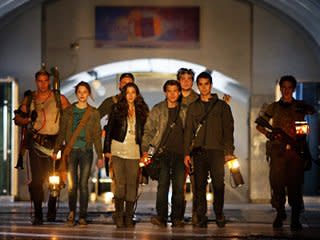The Darkest Hour

When it comes to its creature design, The Darkest Hour opts for a less-is-more approach. Unfortunately, in this case, less is just less. Rather than any Gigeresque monstrosities or the insectoid extraterrestrials of the J.J. Abrams canon, the space invaders of this surprisingly thrill-less Moscow-set thriller are invisible for much of the film. When you can see them, they resemble nothing more exciting than floating Windows screensavers.
By the time these glowing gyros drift down from the night sky like fluff blown off of some cosmic dandelion, we?ve already been introduced to our gang of would-be survivors and have pretty much figured out in what order they?re going to die. Not that we’ll be too upset, as it?s clear from early on that these characters are as indistinct and lazily rendered as the floating blobs chasing them.
The core crew is thus: two American entrepreneurial hopefuls (Emile Hirsch and Max Minghella), a craven and duplicitous Swede (Joel Kinnaman), and two female friends on vacation (Olivia Thirlby and Rachael Taylor), now navigating the Russian capital after much of its population has been reduced to ash. The aliens disintegrate any humans they touch, like the tripods of 2005’s War of the Worlds. But where Steven Spielberg evoked muted horror from the victims’ cindered remains, you get the feeling that The Darkest Hour director Chris Gorak and screenwriter Jon Spaihts just do it because it looks cool. They do manage to eke out some fleeting dread when the creatures’ electrical fields turn a row of flickering streetlamps into a tense, signaled approach. But when the script switches genres, exchanging survival horror for resistance fighting, it loses whatever momentum it had, and you?re left with a battle between two sides, neither of which are particularly interesting. You should be rooting for the humans, but you might as well be rooting for the blobs. Most likely, though, you?ll just be rooting for the credits. D+
